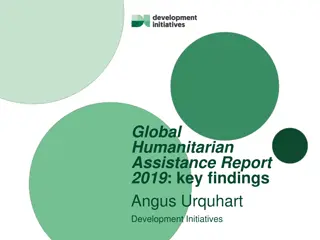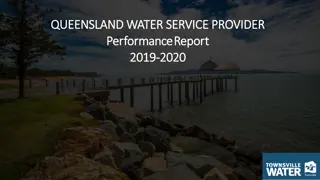Highlights from the 42nd United States/Canada Hydrographic Commission Meeting
The 42nd United States/Canada Hydrographic Commission Meeting was held in conjunction with the US Hydro conference in Biloxi, Mississippi, USA. Key highlights included updates on national reports from the USA and Canada, emphasizing cooperation and collaboration in various areas. The meeting discussed advancements in hydrographic geospatial products and services, focusing on topics such as ENC schemes, grids, and the development of Paper Chart 2.0.
Download Presentation

Please find below an Image/Link to download the presentation.
The content on the website is provided AS IS for your information and personal use only. It may not be sold, licensed, or shared on other websites without obtaining consent from the author. Download presentation by click this link. If you encounter any issues during the download, it is possible that the publisher has removed the file from their server.
E N D
Presentation Transcript
42ND United States/Canada Hydrographic Commission Meeting March 18, 2019 Held in conjunction with US Hydro conference Biloxi, Mississippi, USA 25 attendees
Introductions Meeting was Chaired by RDML Shep Smith, Director of the NOAA Office of Coast Survey Canadian delegation was headed by Dr. Genevi ve B chard, Director General, Canadian Hydrographic Service IHO was represented by Secretary-General Dr. Mathias Jonas Others represented: Royal Canadian Navy (RCN), National Geospatial Intelligence Agency (NGA), US Navy, and the United Kingdom Hydrographic Office
Highlights from National Reports USA reiterated its, Best available data policy (regardless of source). USA is building some ENC only products USA is moving to a gridded scheme for ENCs USA is continueing to develop and implement services for precision navigation including surface currents (S-111) from hydro-dynamic modeling and gridded high-density bathymetry (S-102)
Highlights from National Reports CA is continuing to deliver on Ocean Protection Plan, entering year 3 of 5 year program CA is working on refining a Paper Chart 2.0 solution to produce paper charts from ENCs automatically, with no manual intervention CA is concentrating on digitizing key holdings and releasing more data to the public domain CA has launched a major effort to find the best way of re-scheming ENCs to a national grid
Highlights from National Reports The US and Canada are moving in the same direction in many areas Excellent opportunities for cooperation and collaboration This will be particularly crucial with the re-scheming of ENCs and the delivery of services in trans-boundary waters The goal of the USCHC is to ensure the provision of these products and services to users is as seamless and streamlined as possible
Hydrographic Geospatial Products and Service Committee (HGPSC) Under its new Terms of Reference, this group met formally for the first time by teleconference in February (previously was the Chart Advisory Committee) Topics included: ENC schemes and grids and how they are resolved in the trans-boundary areas Paper Chart 2.0. Face-to-face workshops and other collaborative events are being planned for both these topics 3 paper charts generated automatically from ENCs of varying complexity were displayed. CA and the UK have submitted a paper to HSSC11 requesting that the IHO move to standardize a paper chart specification that is generated exclusively from an ENC
S-100 Services US is looking at standing up a S-111 surface currents service in 2020 that will provide forecasts every 6 hours S-412 weather and wave information may also be included in the service Canada gave on overview of its bathymetric data in the cloud project. This project with TeledyneCARIS, PRIMAR, EEC, and the Norwegian Hydrographic Service (NHS) is working through the challenges of operationalizing the delivery of S-102 gridded bathymetry data RDML Smith tabled his ideas regarding extending the WEND principles to the services (WENS). This is significant as it covers such things as avoiding the duplication of services and utilizing modern delivery mechanisms like those used by RENCs
Technology, Capacity and Cooperation Both nations gave presentations on research and development in the area of autonomous survey platforms. Great promise as a force multiplier, especially in extremely shallow waters and/or areas where there could be significant risk to more traditional platforms Canada is planning to send 3 staff to NOAA to work on their survey ships. Other opportunities for inter-agency exchanges were discussed (e.g. between CHS and NGA). Canada is also hosting a KHOA employee for two years to work on S-100 related implementation issues
Data Contributions The US reported on its gap analysis for Seabed 2030. 42% of US waters are mapped with at least one sounding in a 100m X 100m grid over all US and US territorial waters Canada announced that its 100m resolution bathymetric data set for non- navigation (NONNA-100) is now available through the IHO DCDB and there are plans to release a NONNA-10 dataset in the future. This data is now also available to GEBCO and by extension to the Seabed 2030 project
IHO Related US introduced the Japanese proposed draft amendments to Resolution 1/2005 IHO Response to Disasters. JP and AU are proposing lowering the prescriptions in the resolution to make it much more flexible. Canada is seeking from other CA agencies for their concurrence. USCHC endorsed the revised IHO Resolution 2/1997 on Regional Hydrographic Commissions (RHCs). A brief history of the USCHC, prepared by the US, was presented and approved by the USCHC. This background document will be added to the USCHC IHO Web page.
USCHC Cooperation with Stakeholders OCS held its second Open House on Nautical Cartography in July 2018 automated chart production products and services supporting precision navigation CHS participated in a Mariners Workshop January 2019 dynamic products development Paper Chart 2.0 - positive response, if this approach facilitates access to new information in a more timely manner Crowd-Sourced Bathymetry Working Group (CSBWG) meeting in February related industry/stakeholder workshop Provided opportunities for all to see multiple sides of the issue
Next Meeting The next USCHC meeting will take place February 24, 2020 in Qu bec City, Canada, and will be held in conjunction with the 2020 Canadian Hydrographic Conference (CHC2020)
Actions Required The IRCC is invited to: note this report






























